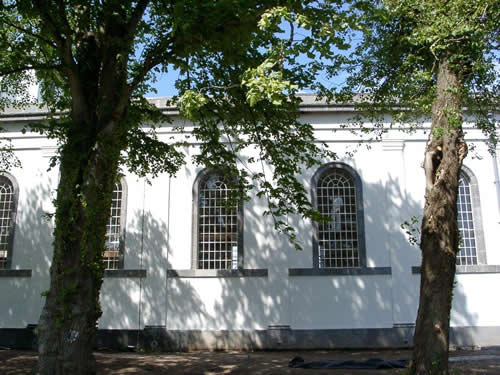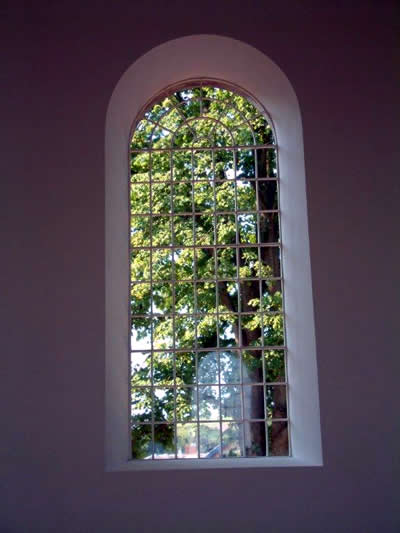Casting a heritage heavyweight
Repair and replacement of historic cast iron windows at t he Garrison Chapel in Pembroke Dock
The processes and precision required in cast-iron production and pattern-making have changed very little over the last century. And yet the task of repairing and replacing historic 19th Century cast iron windows often requires skills as much akin to a master detective as a master craftsman.
And that’s often because loss, erosion and damage over scores of years have transformed the windows of some of the country’s most historic buildings into irregular pieces of heavyweight jigsaw puzzles.
When no original patterns and no record of the original dimensions survive, there is rarely a straightforward formula for 21st century replication of cast iron windows on such important heritage restoration projects.
The Garrison Chapel in Pembroke Dock is a case in point. Built around 1830, it is believed to be the only surviving Georgian classical chapel in South Wales. Jason Evans, who manages the Quality Pembrokeshire Unit at Pembrokeshire County Council explains: “It was designed by the chief architect of the Navy, George Ledwell as the focal point for a busy dockyard producing a variety of vessels from battleships to royal yachts”.
Along with other key buildings (all later Listed), it is particularly interesting because it is an early example of the use of structural iron, having evolved out of the development of iron-framed and clad warships. After surviving in different guises, including theatre and motor museum, the building was listed in 1974 and its closure a year later marked the start of it decline. It was sold to a private developer in 1986, by which time the lead had been stripped from the dome, parapet gutter and roof.

By 2003, when the building became the subject of a Compulsory Purchase Order by Pembrokeshire County Council, it was in a derelict state: the roof had partially collapsed and the structure was shrouded with a roofed scaffolding frame. Sections of the dressed and rendered rubble stone walls were badly damaged and the five cast iron windows on the south side of the building had been replaced in steel.
Ironically, the original cast iron windows on the northern side were in much better condition than the steel replacements which were badly rusted and in very poor condition. Interestingly, the replacements had none of the unique “hopper” style window openings featured on the surviving cast iron counterparts.

Funding for a major restoration programme came through the Heritage Lottery Fund’s Pembroke Dock Townscape Heritage Initiative (THI), a project that was to win awards for architects, Acanthus Holden.
It was clear from the poor state of the building’s south side that all of the rusted steel windows would have to be replaced. Welsh Heritage Construction, the main contractor, repaired around 50 per cent of the surviving cast iron windows in situ, along with some of the damaged stone masonry and glazing.
The remaining 50 per cent of the windows were removed by hand, section by section and the broken fragments sent to Hargreaves Foundry in Halifax. Hargreaves were tasked with casting 11 new windows with a finished height of 4,240mm and width of 1,677 mm, and featuring 80 individual window lights to be cast in grey iron Grade 250 BS EN 1561 1997.
To achieve this, the Hargreaves pattern makers had first to piece together their clutch of clues and replicate the original design using these fragments. Some comprised no more than fragile, slender details, along with photographs of the original hopper openings.
Complex restoration projects such as this require detailed measurements, a task which can occupy an entire day. The dimensions of every detail of the windows are collated to the millimetre, to produce a complex technical drawing.
Accuracy is improved if the original windows can be transferred to the foundry where they can be shot or sandblasted (sand is normally used on fine filigree details and tiny nooks and crannies) to remove all traces of paint and ensure accurate measurements.
Design
The design of new patterns requires supreme skill. Whilst the contours, dimensions and general shape of the castings have to be followed accurately, the pattern maker is also making a tool for the founder. While an architect working on a new project would normally supply detailed drawings with precise dimensions, clearly in the case of the Garrison Chapel no such drawings were available.
So the pattern maker’s extensive training (apprenticeships often last five years), extensive skill and detailed understanding of the foundry process become the tools for masterminding a 3D pattern design.
Pattern Making
Once the design is approved a manufacturing drawing is produced the pattern is made, by hand, usually in FSC-sourced yellow pine, birch plywood or a mahogany timber since these timbers are among the least likely to warp or crack from the stress imposed by the moulding process and storage.
Pattern making, a complex and extremely skilled process, must also allow for shrinkage of the metal as it cools. In the case of grey cast iron, one per cent increments are applied to each dimension.
The main tools used to achieve this precision work are chisels and gauges, many of which are more than a century old and passed from one generation of pattern maker to the next. The process is so complex and detailed that a project on the scale of the Garrison Chapel can require two pattern makers to work up to six weeks.
Once complete, patterns can be re-used to create hundreds, even thousands of moulds. But with zero tolerance of warping, it is imperative patterns are stored in a dry environment before use.
Mould Making
The completed pattern is placed inside a box, in preparation for sand moulding. The interior of the box is coated with micronised talcum powder or micronised aluminium to aid mould release and the box is then packed with recyclable silica sand which is then compacted, often by hand, in another process requiring expert knowledge.
Once the sand-resin mix has set, usually in just half an hour, the pattern is removed from the box. Since the Garrison Chapel windows featured profiles to both exterior and interior, two moulds had to be created, which could be brought together to form two halves of a single casting.
It’s the iron founder’s task to create a runner system – a critical element of the process essential to ensure the molten metal can be poured into the mould at just the right speed. The runner system has three elements, a down peg, run bar and in-gate, all created from the bonded sand and designed to exclude slag from the final casting. This is a critical stage of the process which requires enormous skill and expertise. If the molten iron flows too slowly it will solidify before it reaches the casting shape; too quickly or too violently and it could damage the mould, resulting in expensive scrap castings.
Since size, weight and depth of the decorative windows vary; the founder must also plan for the metal contracting at different rates. To compensate, the founder builds one or more “risers”, to hold a reservoir of molten metal which can then feed back into the mould as the cast iron contracts.
Casting
Iron pouring is the most spectacular and dangerous part of casting the windows, but in fact the least complex of all the processes. The metal is a combination of carbon, silicone, sulphur, manganese and phosphorous, the proportions of which are crucial to determining the grade of cast iron produced. The windows were cast in flake graphite cast iron with a tensile strength of 250 Newtons per square millimetre. The metal is heated in a furnace to a temperature of 1,500oC before the molten iron is poured – in spectacularly fiery scenes – into the mould.
Fettling
Once cooled, the window castings, now solid, must be removed from the mould. All the sand is then recycled to make more moulds.
A “fettler” breaks the sand mould with a sledgehammer and, amid hot and dusty scenes chisel and chips off the runner and riser systems with various power tools, along with protrusions known as flashes – slivers of metal which seep into the spaces between the two mould sections. The casting – weighing up to 250kg is removed carefully by hand in another process requiring skill, experience and great care.
The final stage in the production process involved shot blasting the window casting to base metal, creating a sound base for painting before delivery back to Wales.
Service and sustainability
Now in-situ and performing well in the restored church buildings, the cast iron windows can be expected to provide up to a century of service, after which the entire castings can be recycled.
For more information ring 01422 330607, email This email address is being protected from spambots. You need JavaScript enabled to view it.
or visit www.hargreavesfoundry.co.uk






